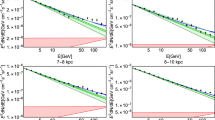Abstract
IceCube has reported the detection of a diffuse TeV-PeV neutrino emission, for which the flat spectrum radio quasars (FSRQs) have been proposed to be the candidate sources. Here we assume that the neutrino flux from FSRQs is proportional to their gamma-ray ones, and obtain the gamma-ray/neutrino flux ratio by the diffuse gamma-ray flux from Fermi-LAT measurement of FSRQs and the diffuse neutrino flux detected by IceCube. We apply this ratio to individual FSRQs and hence predict their neutrino flux. We find that a large fraction of candidate FSRQs from the northern sky in the IceCube point source search has predicted neutrino flux above the IceCube upper limit; and for the sample of stacking search for neutrinos by IceCube, the predicted stacked flux is even larger than the upper limit of stacked flux by orders of magnitude. Therefore the IceCube limit from stacking searches, combined with the Fermi-LAT observations, already rejects FSRQs as the main sources of IceCube-detected diffuse neutrinos: FSRQs can only account for ≲ 10% (≲ 4%) of the IceCube-detected diffuse neutrino flux, according to the stacking searches from the whole (northern) sky. The derived small neutrino/gamma-ray flux ratio also implies that the gamma-ray emission from FSRQs cannot be produced by the secondary leptons and photons from the pion production processes. The caveat in the assumptions is discussed.
Similar content being viewed by others
References
I C Collaboration, Phys. Rev. Lett. 111, 021103 (2013).
I C Collaboration, Phys. Rev. Lett. 113, 101101 (2014).
Ice Cube Collaboration, Science 342, 6161 (2013).
M. Ahlers, and K. Murase, Phys. Rev. D 90, 023010 (2014).
Y. Q. Guo, H. B. Hu, Q. Yuan, Z. Tian, and X. J. Gao, arXiv:1312.7616.
N. Gupta, arXiv:1305.4123.
J. C. Joshi, W. Winter, and N. Gupta, Mon. Not. R. Astron. Soc. 439, 3414 (2014).
C. Lunardini, S. Razzaque, K. T. Theodoseau, and L. Yang, arXiv:1311.7188.
A. Neronov, D. V. Semikoz, and C. Tchernin, arXiv:1307.2158.
S. Razzaque, arXiv:1310.5123.
A. M. Taylor, S. Gabici, and F. Aharonian, arXiv:1403.3206.
I. Cholis, and D. Hooper, J. Cosmol. Astropart. Phys. 6, 030 (2013).
R. Y. Liu, and X. Y. Wang, Astrophys. J. 766, 73 (2013).
K. Murase, and K. Ioka, Phys. Rev. Lett. 111, 121102 (2013).
E. Waxman, and J. Bahcall, Phys. Rev. Lett. 78, 2292 (1997).
C. D. Dermer, K. Murase, and Y. Inoue, arXiv:1406.2633. 17 A. Mücke, R. J. Protheroe, R. Engel, J. P. Rachen, and T. Stanev, Astropart Phys. 18, 593 (2003).
K. Murase, Y. Inoue, and C. D. Dermer, arXiv:1403.4089.
P. Padovani, and E. Resconi, Mon. Not. R. Astron. Soc. 443, 474 (2014).
F. W. Stecker, Phys. Rev. D 88, 047301 (2013).
L. A. Anchordoqui, H. Goldberg, M. H. Lynch, A. V. Olinto, T. C. Paul, and T. J. Weiler, Phys. Rev. D 89, 083003 (2014).
H. N. He, T. Wang, Y. Z. Fan, S. M. Liu, and D. M. Wei, Phys. Rev. D 87, 063011 (2013).
R. Y. Liu, X. Y. Wang, S. Inoue, R. Crocker, and F. Aharonian, arXiv:1310.1263 (2013).
K. Murase, M. Ahlers, and B. C. Lacki, Phys. Rev. D 88, 121301 (2013).
I. Tamborra, S. Ando, and K. Murase, J. Cosmol. Astropart. Phys. 9, 43 (2014).
A. Loeb, and E. Waxman, J. Cosmol. Astropart. Phys. 5, 3 (2006).
B. Wang, X. H. Zhao, and Z. Li, J. Cosmol. Astropart. Phys. 11, 028 (2014).
O. E. Kalashev, A. Kusenko, and W. Essey, Phys. Rev. Lett. 111, 041103 (2013).
R. Laha, J. F. Beacom, B. Dasgupta, S. Horiuchi, and K. Murase, Phys. Rev. D 88, 043009 (2013).
E. Roulet, G. Sigl, A. van Vliet, and S. Mollerach, J. Cosmol. Astropart. Phys. 1301, 028 (2013).
M. Ajello, M. S. Shaw, R. W. Romani, C. D. Dermer, L. Costamante, O. G. King, W. Max-Moerbeck, A. Readhead, A. Reimer, J. L. Richards, and M. Stevenson, Astrophys. J. 751, 108 (2012).
M. Böttcher, A. Reimer, K. Sweeney, and A. Prakash, Astrophys. J. 768, 54 (2013).
I C Collaboration, Astrophys. J. 796, 109 (2014).
Author information
Authors and Affiliations
Corresponding author
Additional information
Recommended by LiXin Li (Associate Editor)
Rights and permissions
About this article
Cite this article
Wang, B., Li, Z. Can FSRQs produce the IceCube detected diffuse neutrino emission?. Sci. China Phys. Mech. Astron. 59, 619502 (2016). https://doi.org/10.1007/s11433-015-5759-3
Received:
Accepted:
Published:
DOI: https://doi.org/10.1007/s11433-015-5759-3




